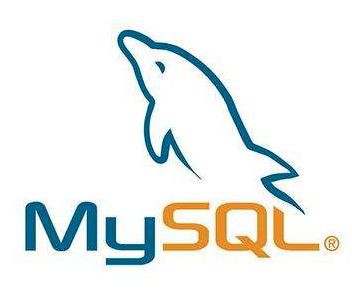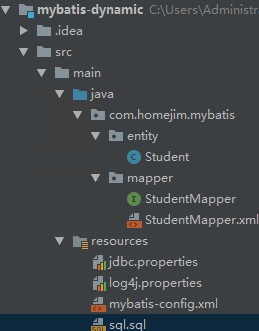作者:阿進的寫字臺
連結:http://www.cnblogs.com/homejim/p/9909657.html

0、一起來學習 mybatis
MyBatis 令人喜歡的一大特性就是動態 SQL。 在使用 JDBC 的過程中, 根據條件進行 SQL 的拼接是很麻煩且很容易出錯的。 MyBatis 動態 SQL 的出現, 解決了這個麻煩。
MyBatis透過 OGNL 來進行動態 SQL 的使用的。
目前, 動態 SQL 支援以下幾種標簽
| 元素 | 作用 | 備註 |
|---|---|---|
| if | 判斷陳述句 | 單條件分支 |
| choose(when、otherwise) | 相當於 Java 中的 if else | 多條件分支 |
| trim(where、set) | 輔助元素 | 用於處理 SQL 拼接問題 |
| foreach | 迴圈陳述句 | 批次插入, 更新, 查詢時經常用到 |
| bind | 建立一個變數, 並系結到背景關係中 | 用於相容不同的資料庫, 防止 SQL 註入等 |
1、資料準備
為了後面的演示, 建立了一個 Maven 專案 mybatis-dynamic, 建立了對應的資料庫和表
DROP TABLE IF EXISTS `student`;
CREATE TABLE `student` (
`student_id` int(10) unsigned NOT NULL AUTO_INCREMENT COMMENT '編號',
`name` varchar(20) DEFAULT NULL COMMENT '姓名',
`phone` varchar(20) DEFAULT NULL COMMENT '電話',
`email` varchar(50) DEFAULT NULL COMMENT '郵箱',
`sex` tinyint(4) DEFAULT NULL COMMENT '性別',
`locked` tinyint(4) DEFAULT NULL COMMENT '狀態(0:正常,1:鎖定)',
`gmt_created` datetime DEFAULT CURRENT_TIMESTAMP COMMENT '存入資料庫的時間',
`gmt_modified` datetime DEFAULT CURRENT_TIMESTAMP ON UPDATE CURRENT_TIMESTAMP COMMENT '修改的時間',
`delete` int(11) DEFAULT NULL,
PRIMARY KEY (`student_id`)
) ENGINE=InnoDB AUTO_INCREMENT=7 DEFAULT CHARSET=utf8mb4 COLLATE=utf8mb4_0900_ai_ci COMMENT='學生表';對應的專案結構

2、if 標簽
if 標簽是我們最常使用的。 在查詢、刪除、更新的時候很可能會使用到。 必須結合 test 屬性聯合使用。
2.1 在 WHERE 條件中使用 if 標簽
這是常見的一種現象, 我們在進行按條件查詢的時候, 可能會有多種情況。
2.1.1 查詢條件
根據輸入的學生資訊進行條件檢索
1、當只輸入使用者名稱時, 使用使用者名稱進行模糊檢索;
2、當只輸入性別時, 使用性別進行完全匹配
3、當使用者名稱和性別都存在時, 用這兩個條件進行查詢匹配查詢
2.1.2 動態 SQL
介面函式
/**
* 根據輸入的學生資訊進行條件檢索
* 1. 當只輸入使用者名稱時, 使用使用者名稱進行模糊檢索;
* 2. 當只輸入郵箱時, 使用性別進行完全匹配
* 3. 當使用者名稱和性別都存在時, 用這兩個條件進行查詢匹配的用
* @param student
* @return
*/
List selectByStudentSelective(Student student); 對應的動態 SQL
<select id="selectByStudentSelective" resultMap="BaseResultMap" parameterType="com.homejim.mybatis.entity.Student">
select
"Base_Column_List" />
from student
where 1=1
<if test="name != null and name !=''">
and name like concat('%', #{name}, '%')
if >
<if test=“sex != null”>
and sex=
if>
select>
在此 SQL 陳述句中, where 1=1 是多條件拼接時的小技巧, 後面的條件查詢就可以都用 and 了。
同時, 我們添加了 if 標簽來處理動態 SQL
<if test="name != null and name !=''">
and name like concat('%', #{name}, '%')
if>
<if test=“sex != null”>
and sex=#{sex}
if>
此 if 標簽的 test 屬性值是一個符合 OGNL 的運算式, 運算式可以是 true 或 false。 如果運算式傳回的是數值, 則0為 false, 非 0 為 true;
2.1.3 測試
@Test
public void selectByStudent() {
SqlSession sqlSession = null;
sqlSession = sqlSessionFactory.openSession();
StudentMapper studentMapper = sqlSession.getMapper(StudentMapper.class);
Student search = new Student();
search.setName("明");
System.out.println("只有名字時的查詢");
List studentsByName = studentMapper.selectByStudentSelective(search);
for (int i = 0; i System.out.println(ToStringBuilder.reflectionToString(studentsByName.get(i), ToStringStyle.MULTI_LINE_STYLE));
}
search.setName(null);
search.setSex((byte) 1);
System.out.println("只有性別時的查詢");
List studentsBySex = studentMapper.selectByStudentSelective(search);
for (int i = 0; i System.out.println(ToStringBuilder.reflectionToString(studentsBySex.get(i), ToStringStyle.MULTI_LINE_STYLE));
}
System.out.println("姓名和性別同時存在的查詢");
search.setName("明");
List studentsByNameAndSex = studentMapper.selectByStudentSelective(search);
for (int i = 0; i System.out.println(ToStringBuilder.reflectionToString(studentsByNameAndSex.get(i), ToStringStyle.MULTI_LINE_STYLE));
}
sqlSession.commit();
sqlSession.close();
} 只有名字時的查詢, 傳送的陳述句和結果

查詢的條件只發送了
where 1=1 and name like concat('%', ?, '%') 只有性別時的查詢, 傳送的陳述句和結果

查詢的條件只發送了
where 1=1 and sex=? 姓名和性別同時存在的查詢, 傳送的陳述句和結果

查詢條件
where 1=1 and name like concat('%', ?, '%') and sex=? 2.2 在 UPDATE 更新列中使用 if 標簽
有時候我們不希望更新所有的欄位, 只更新有變化的欄位。
2.2.1 更新條件
只更新有變化的欄位, 空值不更新。
2.2.2動態 SQL
介面方法
/**
* 更新非空屬性
*/
int updateByPrimaryKeySelective(Student record);對應的 SQL
"updateByPrimaryKeySelective" parameterType="com.homejim.mybatis.entity.Student">
update student
<set>
<if test="name != null">
`name` = #{name,jdbcType=VARCHAR},
if >
<if test=“phone != null”>
phone = #{phone,jdbcType=VARCHAR},
if>
<if test=“email != null”>
email = #{email,jdbcType=VARCHAR},
if>
<if test=“sex != null”>
sex = #{sex,jdbcType=TINYINT},
if>
<if test=“locked != null”>
locked = #{locked,jdbcType=TINYINT},
if>
<if test=“gmtCreated != null”>
gmt_created = #{gmtCreated,jdbcType=TIMESTAMP},
if>
<if test=“gmtModified != null”>
gmt_modified = #{gmtModified,jdbcType=TIMESTAMP},
if>
set>
where student_id = #{studentId,jdbcType=INTEGER}
2.2.3 測試
@Test
public void updateByStudentSelective() {
SqlSession sqlSession = null;
sqlSession = sqlSessionFactory.openSession();
StudentMapper studentMapper = sqlSession.getMapper(StudentMapper.class);
Student student = new Student();
student.setStudentId(1);
student.setName("明明");
student.setPhone("13838438888");
System.out.println(studentMapper.updateByPrimaryKeySelective(student));
sqlSession.commit();
sqlSession.close();
}結果如下

2.3 在 INSERT 動態插入中使用 if 標簽
我們插入資料庫中的一條記錄, 不是每一個欄位都有值的, 而是動態變化的。 在這時候使用 if 標簽, 可幫我們解決這個問題。
2.3.1 插入條件
只有非空屬性才插入。
2.3.2 動態SQL
介面方法
/**
* 非空欄位才進行插入
*/
int insertSelective(Student record);對應的SQL
"insertSelective" parameterType="com.homejim.mybatis.entity.Student">
insert into student
"(" suffix=")" suffixOverrides=",">
<if test="studentId != null">
student_id,
if >
<if test=“name != null”>
`name`,
if>
<if test=“phone != null”>
phone,
if>
<if test=“email != null”>
email,
if>
<if test=“sex != null”>
sex,
if>
<if test=“locked != null”>
locked,
if>
<if test=“gmtCreated != null”>
gmt_created,
if>
<if test=“gmtModified != null”>
gmt_modified,
if>
<if test=“studentId != null”>
#{studentId,jdbcType=INTEGER},
if>
<if test=“name != null”>
#{name,jdbcType=VARCHAR},
if>
<if test=“phone != null”>
#{phone,jdbcType=VARCHAR},
if>
<if test=“email != null”>
#{email,jdbcType=VARCHAR},
if>
<if test=“sex != null”>
#{sex,jdbcType=TINYINT},
if>
<if test=“locked != null”>
#{locked,jdbcType=TINYINT},
if>
<if test=“gmtCreated != null”>
#{gmtCreated,jdbcType=TIMESTAMP},
if>
<if test=“gmtModified != null”>
#{gmtModified,jdbcType=TIMESTAMP},
if>
這個 SQL 大家應該很熟悉, 畢竟是自動生成的。
2.3.3 測試
@Test
public void insertByStudentSelective() {
SqlSession sqlSession = null;
sqlSession = sqlSessionFactory.openSession();
StudentMapper studentMapper = sqlSession.getMapper(StudentMapper.class);
Student student = new Student();
student.setName("小飛機");
student.setPhone("13838438899");
student.setEmail("xiaofeiji@qq.com");
student.setLocked((byte) 0);
System.out.println(studentMapper.insertSelective(student));
sqlSession.commit();
sqlSession.close();
}對應的結果

SQL 中, 只有非空的欄位才進行了插入。
3、choose 標簽
choose when otherwise 標簽可以幫我們實現 if else 的邏輯。
一個 choose 標簽至少有一個 when, 最多一個otherwise
下麵是一個查詢的例子。
3.1 查詢條件
假設 name 具有唯一性, 查詢一個學生
-
-
當 studen_id 有值時, 使用 studen_id 進行查詢;
-
當 studen_id 沒有值時, 使用 name 進行查詢;
-
否則傳回空
3.2 動態SQL
介面方法
/**
* - 當 studen_id 有值時, 使用 studen_id 進行查詢;
* - 當 studen_id 沒有值時, 使用 name 進行查詢;
* - 否則傳回空
*/
Student selectByIdOrName(Student record);對應的SQL
<select id="selectByIdOrName" resultMap="BaseResultMap" parameterType="com.homejim.mybatis.entity.Student">
select
"Base_Column_List" />
from student
where 1=1
<when test="studentId != null">
and student_id=#{studentId}
when >
<when test=“name != null and name != ””>
and name=
when>
and 1=2
select>
3.3 測試
@Test
public void selectByIdOrName() {
SqlSession sqlSession = null;
sqlSession = sqlSessionFactory.openSession();
StudentMapper studentMapper = sqlSession.getMapper(StudentMapper.class);
Student student = new Student();
student.setName("小飛機");
student.setStudentId(1);
Student studentById = studentMapper.selectByIdOrName(student);
System.out.println("有 ID 則根據 ID 獲取");
System.out.println(ToStringBuilder.reflectionToString(studentById, ToStringStyle.MULTI_LINE_STYLE));
student.setStudentId(null);
Student studentByName = studentMapper.selectByIdOrName(student);
System.out.println("沒有 ID 則根據 name 獲取");
System.out.println(ToStringBuilder.reflectionToString(studentByName, ToStringStyle.MULTI_LINE_STYLE));
student.setName(null);
Student studentNull = studentMapper.selectByIdOrName(student);
System.out.println("沒有 ID 和 name, 傳回 null");
Assert.assertNull(studentNull);
sqlSession.commit();
sqlSession.close();
}有 ID 則根據 ID 獲取, 結果

沒有 ID 則根據 name 獲取

沒有 ID 和 name, 傳回 null

4、trim(set、where)
這三個其實解決的是類似的問題。 如我們在寫前面的[在 WHERE 條件中使用 if 標簽] SQL 的時候, where 1=1 這個條件我們是不希望存在的。
4.1 where
4.1.1 查詢條件
根據輸入的學生資訊進行條件檢索。
1、當只輸入使用者名稱時, 使用使用者名稱進行模糊檢索;
2、當只輸入性別時, 使用性別進行完全匹配
3、當使用者名稱和性別都存在時, 用這兩個條件進行查詢匹配查詢
不使用 where 1=1。
4.1.2 動態 SQL
很顯然, 我們要解決這幾個問題
-
當條件都不滿足時: 此時 SQL 中應該要不能有 where , 否則導致出錯
-
當 if 有條件滿足時: SQL 中需要有 where, 且第一個成立的 if 標簽下的 and | or 等要去掉
這時候, 我們可以使用 where 標簽。
介面方法
/**
* 根據輸入的學生資訊進行條件檢索
* 1. 當只輸入使用者名稱時, 使用使用者名稱進行模糊檢索;
* 2. 當只輸入郵箱時, 使用性別進行完全匹配
* 3. 當使用者名稱和性別都存在時, 用這兩個條件進行查詢匹配的用
*/
List selectByStudentSelectiveWhereTag(Student student) ;對應的 SQL
<select id="selectByStudentSelectiveWhereTag" resultMap="BaseResultMap" parameterType="com.homejim.mybatis.entity.Student">
select
"Base_Column_List" />
from student
<where>
<if test="name != null and name !=''">
and name like concat('%', #{name}, '%')
if >
<if test=“sex != null”>
and sex=
if>
where>
select>
4.1.3 測試
@Test
public void selectByStudentWhereTag() {
SqlSession sqlSession = null;
sqlSession = sqlSessionFactory.openSession();
StudentMapper studentMapper = sqlSession.getMapper(StudentMapper.class);
Student search = new Student();
search.setName("明");
System.out.println("只有名字時的查詢");
List studentsByName = studentMapper.selectByStudentSelectiveWhereTag(search);
for (int i = 0; i System.out.println(ToStringBuilder.reflectionToString(studentsByName.get(i), ToStringStyle.MULTI_LINE_STYLE));
}
search.setSex((byte) 1);
System.out.println("姓名和性別同時存在的查詢");
List studentsBySex = studentMapper.selectByStudentSelectiveWhereTag(search);
for (int i = 0; i System.out.println(ToStringBuilder.reflectionToString(studentsBySex.get(i), ToStringStyle.MULTI_LINE_STYLE));
}
System.out.println("姓名和性別都不存在時查詢");
search.setName(null);
search.setSex(null);
List studentsByNameAndSex = studentMapper.selectByStudentSelectiveWhereTag(search);
for (int i = 0; i System.out.println(ToStringBuilder.reflectionToString(studentsByNameAndSex.get(i), ToStringStyle.MULTI_LINE_STYLE));
}
sqlSession.commit();
sqlSession.close();
} 只有名字時的查詢, 有 where

姓名和性別同時存在的查詢, 有 where

姓名和性別都不存在時查詢, 此時, where 不會再出現了。

4.2 set
set 標簽也類似, 在 [2.2 在 UPDATE 更新列中使用 if 標簽] 中, 如果我們的方法 updateByPrimaryKeySelective 沒有使用
4.3 trim
set 和 where 其實都是 trim 標簽的一種型別, 該兩種功能都可以使用 trim 標簽進行實現。
4.3.1 trim 來表示 where
如以上的 where 標簽, 我們也可以寫成
<trim prefix="where" prefixOverrides="AND |OR">
trim>表示當 trim 中含有內容時, 新增 where, 且第一個為 and 或 or 時, 會將其去掉。 而如果沒有內容, 則不新增 where。
4.3.2 trim 來表示 set
相應的, set 標簽可以如下表示
<trim prefix="SET" suffixOverrides=",">
trim>表示當 trim 中含有內容時, 新增 set, 且最後的內容為 , 時, 會將其去掉。 而沒有內容, 不新增 set
4.3.3 trim 的幾個屬性
-
prefix: 當 trim 元素包含有內容時, 增加 prefix 所指定的字首
-
prefixOverrides: 當 trim 元素包含有內容時, 去除 prefixOverrides 指定的 字首
-
suffix: 當 trim 元素包含有內容時, 增加 suffix 所指定的字尾
-
suffixOverrides: 當 trim 元素包含有內容時, 去除 suffixOverrides 指定的字尾
5、foreach 標簽
foreach 標簽可以對陣列, Map 或實現 Iterable 介面。
foreach 中有以下幾個屬性
-
collection: 必填, 集合/陣列/Map的名稱.
-
item: 變數名。 即從迭代的物件中取出的每一個值
-
index: 索引的屬性名。 當迭代的物件為 Map 時, 該值為 Map 中的 Key.
-
open: 迴圈開頭的字串
-
close: 迴圈結束的字串
-
separator: 每次迴圈的分隔符
其他的比較好理解, collection 中的值應該怎麼設定呢?
跟介面方法中的引數相關。
1、只有一個陣列引數或集合引數
預設情況: 集合collection=list, 陣列是collection=array
推薦: 使用 @Param 來指定引數的名稱, 如我們在引數前@Param(“ids”), 則就填寫 collection=ids
2、多引數
多引數請使用 @Param 來指定, 否則SQL中會很不方便
3、引數是Map
指定為 Map 中的對應的 Key 即可。 其實上面的 @Param 最後也是轉化為 Map 的。
4、引數是物件
使用屬性.屬性即可。
5.1 在 where 中使用 foreach
在 where條件中使用, 如按id集合查詢, 按id集合刪除等。
5.1.1 查詢條件
我們希望查詢使用者 id 集合中的所有使用者資訊。
5.1.2 動態 SQL
函式介面
/**
* 獲取 id 集合中的使用者資訊
* @param ids
* @return
*/
List selectByStudentIdList(List ids); 對應 SQL
<select id="selectByStudentIdList" resultMap="BaseResultMap">
select
"Base_Column_List" />
from student
where student_id in
<foreach collection="list" item="id" open="(" close=")" separator="," index="i">
#{id}
foreach >
select>
5.1.3 測試
@Test
public void selectByStudentIdList() {
SqlSession sqlSession = null;
sqlSession = sqlSessionFactory.openSession();
StudentMapper studentMapper = sqlSession.getMapper(StudentMapper.class);
List ids = new LinkedList<>();
ids.add(1);
ids.add(3);
List students = studentMapper.selectByStudentIdList(ids);
for (int i = 0; i System.out.println(ToStringBuilder.reflectionToString(students.get(i), ToStringStyle.MULTI_LINE_STYLE));
}
sqlSession.commit();
sqlSession.close();
} 結果

5.2 foreach 實現批次插入
可以透過foreach來實現批次插入。
5.2.1 動態SQL
介面方法
/**
* 批次插入學生
*/
int insertList(List students) ;對應的SQL
"insertList">
insert into student(name, phone, email, sex, locked)
values
<foreach collection="list" item="student" separator=",">
(
#{student.name}, #{student.phone},#{student.email},
#{student.sex},#{student.locked}
)
foreach >
5.2.2 測試
@Test
public void insertList() {
SqlSession sqlSession = null;
sqlSession = sqlSessionFactory.openSession();
StudentMapper studentMapper = sqlSession.getMapper(StudentMapper.class);
List students = new LinkedList<>();
Student stu1 = new Student();
stu1.setName("批次01");
stu1.setPhone("13888888881");
stu1.setLocked((byte) 0);
stu1.setEmail("13888888881@138.com");
stu1.setSex((byte) 1);
students.add(stu1);
Student stu2 = new Student();
stu2.setName("批次02");
stu2.setPhone("13888888882");
stu2.setLocked((byte) 0);
stu2.setEmail("13888888882@138.com");
stu2.setSex((byte) 0);
students.add(stu2);
System.out.println(studentMapper.insertList(students));
sqlSession.commit();
sqlSession.close();
} 結果

6、bind 標簽
bind 標簽是透過 OGNL 運算式去定義一個背景關係的變數, 這樣方便我們使用。
如在 selectByStudentSelective 方法中, 有如下
<if test="name != null and name !=''">
and name like concat('%', #{name}, '%')
if>
在 MySQL 中, 該函式支援多引數, 但在 Oracle 中只支援兩個引數。 那麼我們可以使用 bind 來讓該 SQL 達到支援兩個資料庫的作用
<if test="name != null and name !=''">
<bind name="nameLike" value="'%'+name+'%'"/>
and name like #{nameLike}
if>
更改後的查詢結果如下

7、程式碼
使用示例:https://github.com/homejim/mybatis-examples
●編號520,輸入編號直達本文
●輸入m獲取文章目錄

Web開發
更多推薦《25個技術類公眾微信》
涵蓋:程式人生、演演算法與資料結構、駭客技術與網路安全、大資料技術、前端開發、Java、Python、Web開發、安卓開發、iOS開發、C/C++、.NET、Linux、資料庫、運維等。
 知識星球
知識星球
